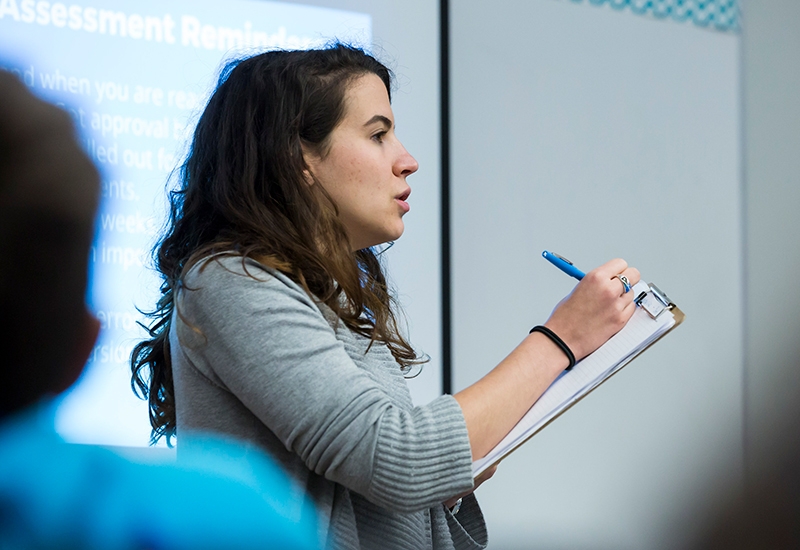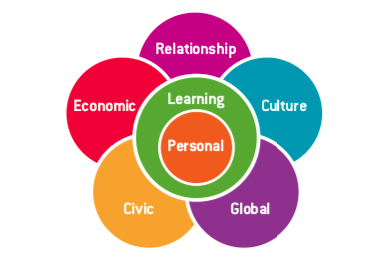Key Takeaways
- Leaders supporting educator transition to innovative environments will understand why it is important to build a contextual understanding of the “why” behind new approaches.
- Professional development (PD) and training designers will explore and learn strategies for communicating the vision and “why” behind design choices in an innovative school and/or district/network model.

What is the problem?
Many new teachers (whether new to the profession and/or new to the district/network) enter innovative schools and are asked to implement new models and instructional approaches they have neither experienced nor heard of in their undergraduate programs or prior teaching placements. This can lead to confusion, discomfort, and a disconnect between their expectations and those of the school in which they serve.
In order to address this challenge and ensure all new teachers have a clear understanding of not only the teaching and learning model in practice but also the “why” behind the current approach, PD designers must figure out a way to share those answers in a clear and tangible way to new teachers during their onboarding process.
PD designers should ask themselves these key questions:
- How can I communicate the impetus for our instructional shifts, and how they are tied to specific instructional challenges we are trying to address?
- How can I help teachers understand the journey we took to get where we are today?
- What strategy will I use to ensure new teachers understand and have ownership of the vision of the school and its future?
Why is it important?
When entering a new school, both novice and veteran teachers are met with a multitude of challenges, including getting to know their school, students, the curriculum, and the instructional approaches being implemented. These pieces can seem disconnected if they are not brought together under a common understanding of the “why” behind them. Clearly communicating these reasons to new teachers enables them to understand how the instructional approach was designed to match the needs of the school and students. Learning about the “why” during onboarding will also give new teachers the opportunity to better comprehend the challenges and journey that came before them and how they can fit into the future of the school in a meaningful way.
The research says...
Researchers who study successful change management and adoption of initiatives frequently find that:
- Building staff understanding of vision through effective, consistent communication is critical to the success of any change initiative (Kotter, 1995).
- Changes in teacher practice are strongly tied to practitioner beliefs about how new approaches will lead to improved outcomes in their classrooms. Effective professional development must address the need for change connected to a clear theory for how successful implementation will meet that need (Guskey, 2002).
- Developing a shared vision through professional learning is critical to success in supporting teachers to implement new innovations such as technology (Ertmer, Ottenbriet- Leftridge, 2010).

How: Solution
When constructing the first few days and weeks of onboarding, PD designers must first ensure that all new teachers understand the “why” of a schools’ specific approach to teaching and learning. This will help new teachers transition to the school and ensure all stakeholders understand the mission and vision of the school and model. The next three sections will share a few ways schools, districts, and networks from across the country have communicated their “why” in engaging and tangible ways:
Instructional Challenge/Impetus for Change
What was your impetus for shifting? What were the instructional challenges you were trying to address? All effective transformation efforts - whether they focus on technology or not - start with crafting a clear “why” for the changes that will be asked of practitioners, students, and other community members. Leaders should continuously ask themselves these questions to ensure the current model is tied to specific goals and/or instructional challenges they face.
Given different schools will be motivated by different contexts and goals, there are many reasons for implementing a new approach, some of which are tied to addressing specific challenges as well as others that are connected to aspirational goals and visions for the future. Examples of instructional challenges schools, districts, and networks have identified as an impetus for change include:
- Students not engaged in their own learning.
- A need for more time for 1:1 conferencing or small group instruction.
- A persistent achievement gap, with test scores that range widely from below basic through advanced.
PD leaders onboarding new teachers must clearly communicate the impetus behind the change. Hear from Gara Field, principal at Pleasant View Elementary, about why they decided to shift to an innovative learning model in the video below.
Here are a few ways other districts and networks have communicated the reasons behind their shift. These artifacts should not be seen as strategies to copy and paste, but instead should serve as examples of different ways to communicate the impetus behind your shift in a clear and engaging way.
Sharing the Journey to the Present
What was the journey you took to get where you are today? It is not only important that new teachers understand your current model and the reason your school shifted – they should also understand how you got there and be able to understand where the community is headed next in meeting its goals. This provides new teachers the opportunity to see how the pieces of the puzzle all work together.
In interviews, many school leaders have mentioned that when they don’t share the challenges, obstacles, and triumphs that came before, new teachers aren’t able to fully see all of the connections and reasons behind various decisions. In order to help educators see the full picture behind your school’s shift, you could communicate your school’s journey through a slide deck, conversation, or even a video, as seen below from LeViis Haney of Lovett Elementary School.
When exploring the additional resources below, think about your own journey and what key points you should share during new teacher onboarding.
Defining and Sharing the School’s Vision
What is the vision for the school (and its future)? The last component you need to think about when communicating the “why” is how you will share the comprehensive vision for your school, district, or network. (If you haven’t yet defined this, you should start by asking what the long-term goals for the school and community are and how they fit into the greater vision of the district or network.)

Lindsay Unified's Lifelong Learning Standards
Vision statements can come in many different forms, from a brief vision statement, to an image, to a fully constructed strategic plan. The artifacts highlighted below illustrate multiple approaches that range from defining a vision to full district design plans. When looking at the documents, ask yourself how you could present these to new teachers in an engaging and actionable manner so that they, too, are brought into the vision of your school, district, or network.
Additional approaches to sharing the "why":
To explore additional ways to communicate the “why” behind shifting to innovative models from teacher, student, and administrator perspectives.